‘We are democratising the right to laziness’: the rise of on-demand grocery deliveries | Life and style
One Friday afternoon in May, Glenn Cobane, 40, who lives with his wife and two cats in Salford, did some grocery shopping: a loaf of bread, bananas, an avocado, cat food, chocolate brownies and some cans of beer. Rather than going to a nearby corner shop or walking a mile to the large Tesco Extra, he bought the food and drink from a new app called Weezy. He placed the order at 2.19pm. “I just sent the order, typed an email and then it arrived.” he says. It is now 2.27pm, and I’m standing on his doorstep beside the courier.
“This is the third or fourth time I’ve used them in the past fortnight,” Cobane says. The Weezy delivery rider might have shaved a few minutes off the mile-long journey from the warehouse to Cobane’s house on his e-bike if he hadn’t had to wait for me to keep up.
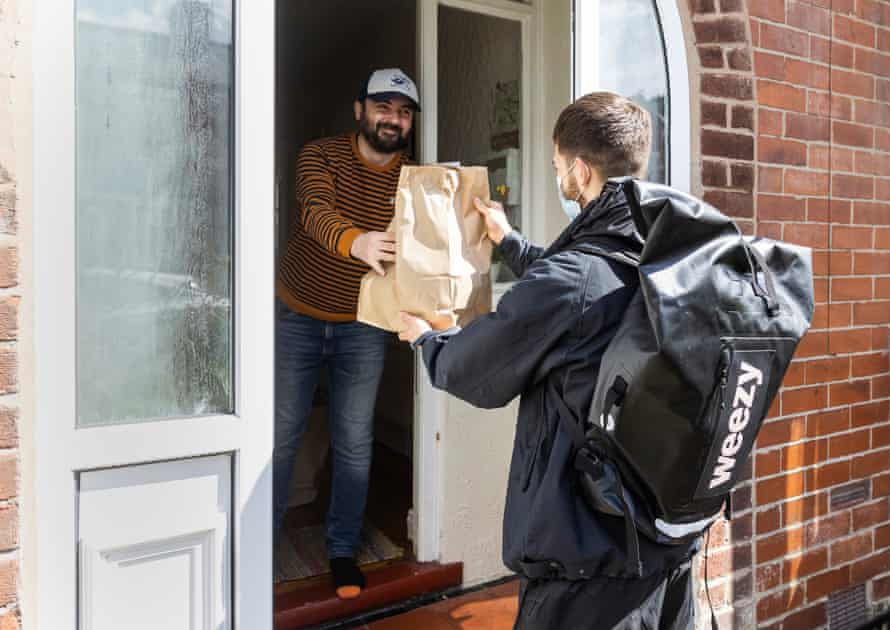
Why not pop to the Costcutter, which I can see from his garden? “The app has a better selection. It has cat food and, more importantly, beer,” says Cobane, laughing, pulling out the cans of Marble, a local brew. “It’s very good, you can’t get it from a corner shop.”
Why not a big supermarket, with an array of beer and cat food? “I plan to continue working from home, so I’ll be reliant on these services – it’s just a lot easier,” he says. Cobane works in the construction industry and orders online from Tesco and Sainsbury’s about once a fortnight, but frequently runs out of fresh food or beer. “I haven’t been inside an actual supermarket since October. I’m hoping to not go back for as long as possible.” Because of Covid? “Because it’s boring, and it’s time-consuming and, you know, I’ve been doing it for 25 years.” He shrugs. “I am embracing the future.”
At least 10 different on-demand grocery companies have emerged over the last year, with names that make them sound like Snow White’s other dwarves: Weezy, Jiffy, Dija, Zapp, Fancy, Getir and Gorillas are just some of them. All have bold, bright, branding; all hire young couriers riding e-bikes, bicycles or scooters; all promise to deliver essentials including food, drink, cat treats, pregnancy kits and loo rolls “in minutes”. Some aim for 20 minutes, some promise 10. They have started hiring thousands of couriers and renting out mini-warehouses, mostly in London, but also in Brighton, Bristol, Cambridge, Birmingham, Leeds, Liverpool and Manchester. Established supermarkets are racing to capture the same market: both Sainsbury’s and Tesco are trialling rapid services. Despite existing for only a few months, some of the new companies have raised eye-popping sums from venture capital firms (one estimate puts investment at £9.8bn since the start of the pandemic) which, in turn, are convinced that Cobane is right: this is the future.
One investor, Ophelia Brown at Blossom Capital, says: “We think Dija [a brand she has backed] could be worth £100bn.” (Tesco – founded in 1919 and with 4,500 stores around the world – is worth £17bn. Dija started delivering groceries in March and has 24 stores.) She is not a lone fantasist – there are many who believe the grocery industry is about to experience a revolution; one as transformative as when the Co-operative Society opened a self-service store in London in 1948, allowing shoppers to pick their own items off the shelf, rather than wait for a grocer behind a counter to serve them. On-demand has transformed the taxi industry, restaurants and dating; Netflix and Deliveroo have made billions out of people too lazy to leave the sofa. Could these brands do the same for snacks? And what would that do to the local shops?
The idea is already popular in other countries. Getir, a Turkish company now in London, has “millions of people placing orders every month” in Istanbul and other Turkish cities since its launch in 2015, according to Turancan Salur, Getir UK’s general manager. He says: “We are democratising the right to laziness.” Partly fuelled by the pandemic, millions more now shop for food online. In February 2020, only £7.40 of every £100 spent on groceries in the UK was bought online, according to Kantar, a research company that tracks the industry. By February this year, it had shot up to £15.40. A generation of change was squeezed into one year.
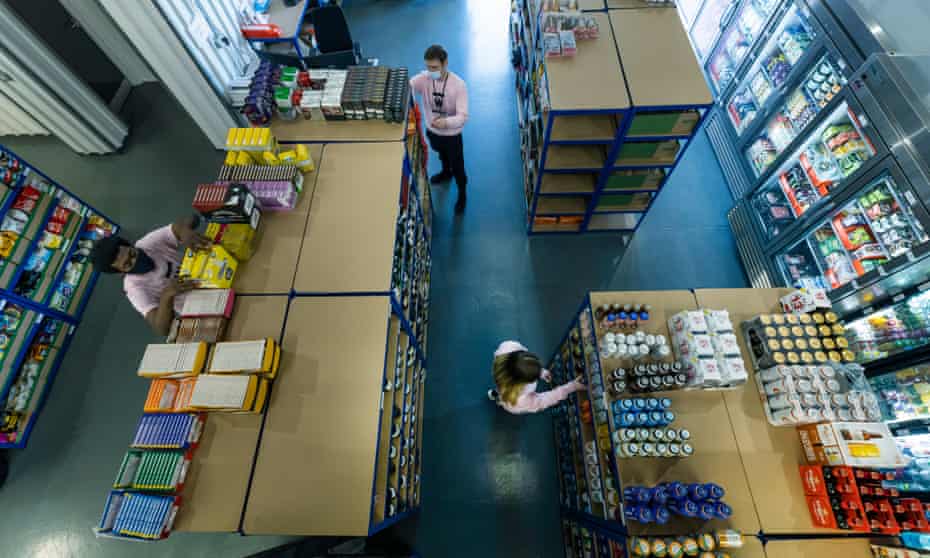
“There has been significant growth from offline to online over the last one and a half years,” says Kristof Van Beveren, 38, a Belgian engineer who founded Weezy with former Oxford University Boat Race winner Alec Dent, 31, who previously worked for BlaBlaCar, an on-demand car-pooling company.
“Now there is a second move from online to on-demand. It’s a wave that we are riding.” Van Beveren speaks quickly, with only a light accent (English is one of his six languages), as he and Dent show me around one of Weezy’s warehouses in London. Both are wearing pink sweatshirts branded with the company logo. And how big is that wave? “If you take European groceries, it’s a multi-trillion dollar business.” Van Beveren says. A former McKinsey employee, he speaks with the slightly unnerving self-belief of a management consultant.
Isn’t it fanciful to think he could get a significant chunk of the £2tn European grocery market? “Not at all,” he says. “Groceries are universal: everyone has to eat. Your typical tech startup that pops up in London goes to a very small audience: early adopters, millennials. Our customers are all over, and range from 15 to 85 years old. Our app is already targeting such a big audience from the get-go. So, where’s the limit?”
Back in Salford, after a mid-afternoon lull, orders start to come in – many involving beer, pet food and what looks to be pretty tasty sourdough. Some, luckily for me, are just four minutes away from the warehouse near Media City.
Others are a longer ride, involving negotiating the underpass beneath the M602. Tyler Kernick, 25, a student at Salford University, is trying it out for the first time after a friend sent him a discount code. He lives just outside the delivery area, so he’s walked across Peel Park to be within the zone, and is standing on the pavement waiting for us. He laughs when we come to a halt with seconds to spare. “It said delivery in 15 minutes. And that sounded pretty crazy. So, I thought I’d give it a try to see if it works. And it did!”

just outside the delivery area in Salford. Photograph: Fabio De Paola/The Guardian
He’s bought coffee pods, a bar of soap, frozen oven chips, chocolate-covered Hobnobs, bread, prawn cocktail crisps and some Haribo Tangfastics. He says he could have gone to his local Asda, “but that’s an hour out of my day”, and while he does have a corner shop, “it’s pretty crappy, to be honest”.
Like many, he says a weekly shop requires planning. The app doesn’t. Indeed, most of our food shopping isn’t planned. Kantar estimates that 63% of all our grocery shopping is what it calls a “basket shop” – a pack of biscuits picked up at lunchtime, or a top-up at the corner shop for milk and loo roll – rather than a big weekly trip or planned online shopping. Could these startups get all of that 63%? It’s highly unlikely but, as Matt Botham, an analyst at Kantar, says, “They are betting on the lazy pound.”
“It’s almost impossible to order an online delivery to arrive at your home quicker than walking to your local convenience shop,” says Thomas Brereton, retail analyst at market research firm GlobalData. These companies aim to change that.
But Dent says it’s “a misconception” that the on-demand grocery business is just about selling beer, crisps and Haribo to drunk people on their sofas at 10pm. “In fact, 50% of what we sell is fresh.” The next step is offering meal and recipe suggestions, for customers to cook from scratch. He says a corner shop just can’t offer that level of “inspiration”.
One rival goes even further in his ambition, suggesting that selling groceries in a swipe is akin to building critical urban infrastructure. “If I was to look back 100 years, if you wanted water, most of the households in our country needed to take the bucket and go to the local water source,” says Vladimir Kholyaznikov, who was born in Belarus and has worked for various Russian online retailers. Aged 37, he is now in London to set up Jiffy. “Now, you have pipes in your flat that give you water on demand. Grocery delivery is going to duplicate that.”
For now, his strategy is to target young adults with discounted ice-cream. Like many of the apps, Jiffy has been paying micro-influencers on Instagram to promote its site, while also giving away discounts to potential shoppers – a strategy that appears to have worked. Or it was on the day I visited his warehouse in a railway arch in Waterloo. Jiffy’s neighbour, on one side, is Getir. Around the back of the arches, Dija and Zapp also have sites. These “dark stores” look like mini shops, but have no real customers nor tills, only couriers picking up orders.
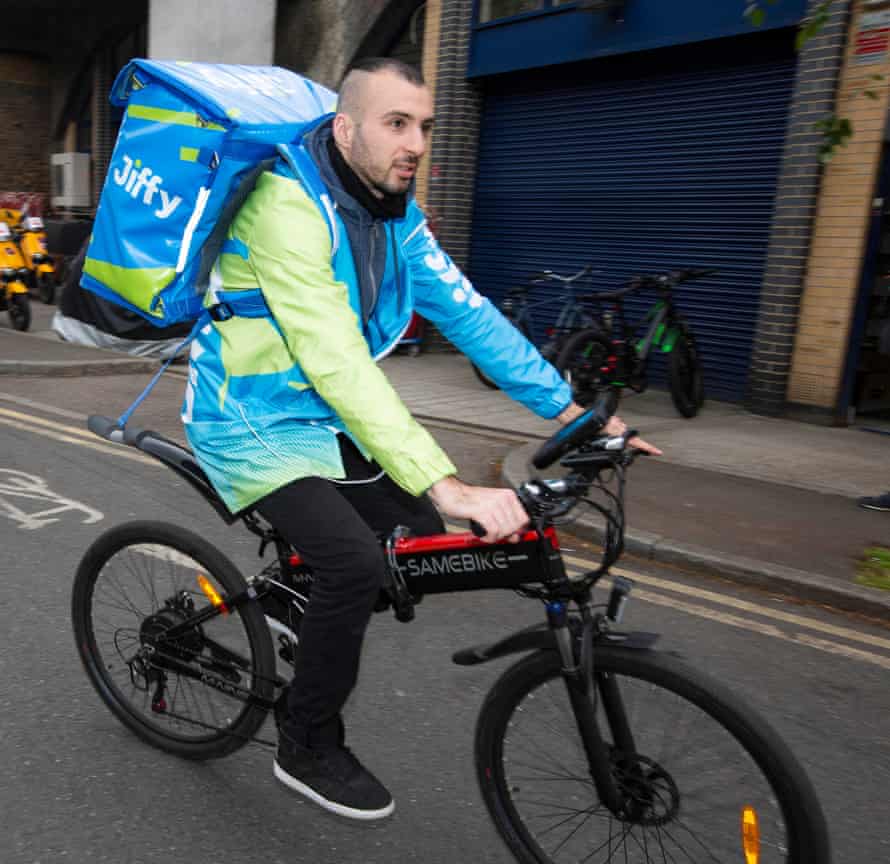
“We think the more competitors at the beginning, the better,” says Kholyaznikov. “It educates the customer that there is this alternative to going to the store.” He is an inveterate entrepreneur, having worked for his parents’ import business as a teenager before ending up running the online food delivery arm of X5 Retail, a Russian giant. He is confident, having seen on-demand groceries take off in 20 different Russian cities, that Jiffy can end up with “hundreds of stores” in the UK very soon.
Currently, he has six. The Waterloo store is innocuous behind shutters. There is a desk, but otherwise it is just a large chiller cabinet, a freezer and shelves stocking about 900 different items – mostly fairly basic: Heinz tomato soup, Prince’s corned beef, Jamie Oliver-branded risotto rice, Bird’s custard powder, fresh veg as well as some steaks. The manager explains that the range will soon expand to about 1,500 items – the same as a small Aldi or Lidl. Some companies have as many as 4,000 items, still considerably fewer than a large supermarket, which has about 30,000 products.
There are eight workers in the Jiffy store: four riders wearing acid-blue tops, two pickers, a shift supervisor and the manager. When an order arrives, a horn noise is sounded from the computer on the supervisor’s desk and the order is sent to an app on the picker’s phone, telling them the shelf location of each item. They dash around with a trolley, finding the items and putting them in a paper bag, before handing the bag over to the e-bike riders. There is a poster telling riders when they arrive at the customer’s home to “be friendly and smiling”, “find out how they heard about Jiffy” and ask if they mind having a photo taken with their bag “for our social media account”.
Though Jiffy’s website promises “groceries in 15 minutes”, when you place an order the app gives you an estimated delivery time, which can be more than 20 minutes if you live far from the dark store. During my afternoon there, some customers were ordering from just 600 metres away (taking only four minutes to pick, pack and arrive); one was from 2.6 miles away, which took about 20 minutes to the doorstep.
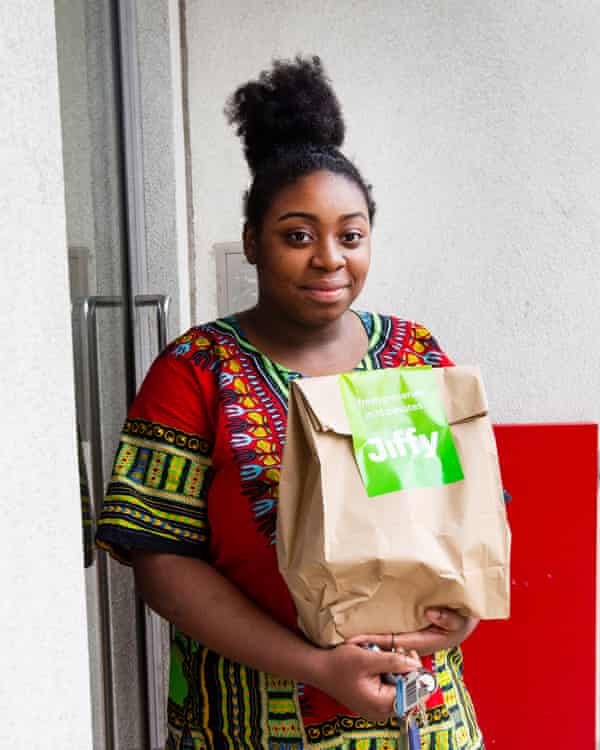
Every customer I speak to has ordered because of seeing the ice-cream offer on Instagram or being sent an alert on their phone. Josephine Henry, 19, a student and mother of eight-month-old Jaden, lives near Victoria station, about two miles from the dark store. She has ordered three tubs of Ben & Jerry’s, costing £8.22. Amused at being caught out buying nothing more than ice-cream, she makes the point that Jiffy and Getir, which she also uses, are often better value than the supermarket. For now, Jiffy is offering free delivery, which is unusual: Weezy charges £2.95, Zapp £1.99, but both offer free delivery on orders over £30. The prices these on-demand grocers charge for items tend to be mostly in line with Tesco Express or Sainsbury’s Local, which are 8-9% more expensive than a standard Tesco or Sainsbury’s, according to Which?, the consumer group. But Henry lives close to a large Sainsbury’s. Could she not get a better selection by walking there? “Early in the morning, if I don’t have the energy to go to the shop or if Jaden is being fussy and I have no one to go to the shop for me, I get it on the app. It’s just easier.”
She says the quality of the goods is sometimes better than at the supermarket. “At Getir, they have this brand of organic baby food I’ve never seen before, which Jaden really likes.”
There are many potential customers for whom just popping to the local shops is difficult. Steve O’Hear, 45, has recently joined Zapp as its head of strategy. He has muscular dystrophy and uses a wheelchair. “For me, when you are disabled, doing things for yourself is super-empowering.” He says he was a big internet shopper already, but “a service that can fill the gaps between planned shopping is potentially a gamechanger”.
“The purple pound is huge,” he adds, referring to disabled people’s consumer spending. “Plus, you have an ageing population. History shows that when you solve a problem for one part of the community, it turns out to be a problem many more people share.”
But could these apps cause a problem for some people – the shopkeepers on the struggling British high street? Convenience stores have been in steady, if gradual, decline for 20 years as supermarkets and discount shops, such as Poundland, have grown in influence. It’s true that over the past year local stores did well, with many consumers shopping locally. But 20 years ago, there were more than 55,000 convenience shops in the UK; now there are fewer than 47,000.
“It is a worry,” says Rav Garcha, 39, who runs five corner shops in the Midlands, started by his father, who emigrated from India in the late 1970s. “We’ve grown a business and served our local communities, and we don’t want the rug pulled out from under us.”
He says he is not against internet shopping – he started to do online deliveries from his shops during the pandemic, signing up to a software platform called Appy Shop that many local shops joined. More than 1,000 have signed up with a rival called Snappy Shopper, a service backed by Justin King, the former Sainsbury’s chief executive. It promises to deliver groceries from corner shops in 30 minutes. But Garcha is nervous about competition from dark stores. “At the moment they are warehouses, but what’s to stop them operating out of a garage, or a front room, or a shed? That’s what I am really worried about. It’s all just so faceless. Being a local business matters.”
Babita Sharma is author of The Corner Shop, part history of the convenience shop in Britain and part memoir about growing up in a corner shop in Reading. “Corner shops have a place in people’s hearts because there is a recognisable face behind the counter every day when you go in to buy your pint of milk.” She is not pessimistic about the venture-capital-backed companies, however. “New entrants into the market might be a threat to them initially, but it’s unlikely to be the final nail in the coffin for corner shops because they have proven to be so resilient in the past.”
During lockdowns, many city dwellers walked to their corner shop every day for something to do, a ritual that was productive and also supported a local business. “It used to be hordes of kids on their bikes who’d gather outside corner shops; over the last year it’s been hordes of families,” Garcha says. “That sense of community has stayed even as lockdown has eased.”
In London, following Jiffy riders around is tough. Its delivery area is large, the traffic is heavy and many of the customers live in blocks of flats with lots of stairs. During my day on the road in Salford, all the customers lived on the ground floor or – even better – in semis with front gardens where you can perch your bike without needing to lock it up.
In Salford, most of the riders are very young. Matthew Wright is on a break before going off to university to study finance. Aged 17, he’s too young to be allowed to deliver alcohol. Sean Holehouse is only two years older, but has already worked for Amazon, the big Kellogg’s factory in Trafford Park, and most recently UberEats, an offshoot of Uber which delivers food from participating restaurants. “UberEats – you can only work when people are hungry: morning, dinner, tea. Here I’m paid by the hour.” Shy at first, he is cautiously enthusiastic when I ask about the job. A keen boxer, he enjoys the cycling, he says, but mostly he likes the pay.
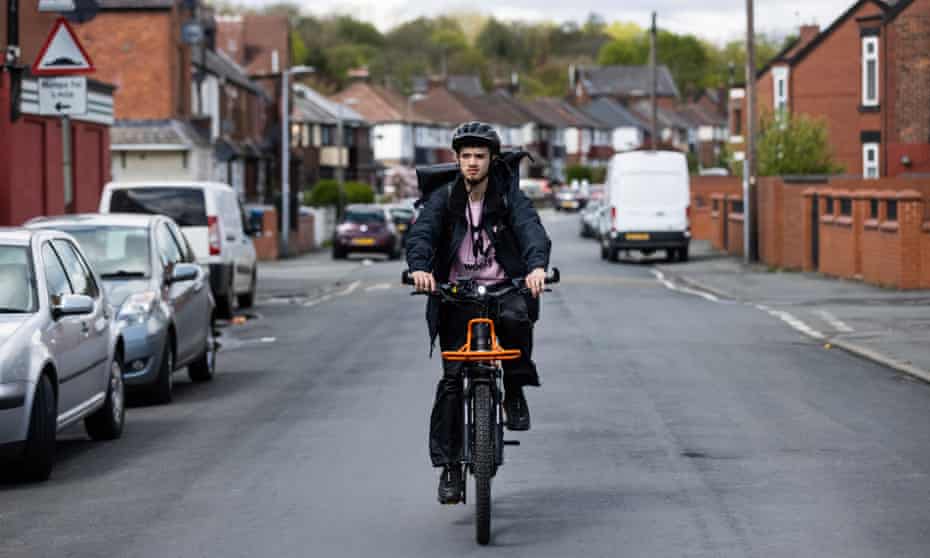
He estimates he was earning £150 a week working for UberEats, where he rode a pedal bike; here he gets to use Weezy’s e-bikes and is paid £10 an hour. “This pays nice. I got paid £650 for last week.” When I ask how he accrued so much, he explains it included a bank holiday. “I’ve been doing loads of hours. The week before I got £480, the week before £500 and something. I have had so many crap jobs that when it comes to this job I really appreciate it.”
All the on-demand brands have decided to hire pickers and riders as proper employees, rather than gig-economy workers. Riders are mostly paid between £10 and £11 an hour – regardless of how many orders they deliver. But how long can the companies afford to pay riders a premium above the supermarket industry, where entry-level jobs are at the minimum wage: £6.56 for a 19-year-old, £8.91 for those over the age of 23? The companies insist it makes business sense, partly because the riders are the face of the brand; partly, as one executive says, they are keen to avoid the “churn” or staff turnover that Deliveroo and other food delivery companies suffer from.
While investors keep piling in – Getir’s latest fundraising in April values it at at least £5bn – it’s not a given that these on-demand services will make a profit. Supermarkets generate only £3 or £4 of profit for every £100 they sell and have struggled to make online deliveries profitable due to the cost of the picking and delivering to customers, though a lot of their costs are tied up in expensive refrigerated vans. Most of the on-demand apps are leasing e-bicycles at minimal cost, with the benefit, they argue, of being good for the environment.
But analysts say that, as with most technology startups, profit is not these apps’ immediate goal: “Their strategy is: don’t make money at the start, build big, get a lot of customers, then focus on turning a profit a few years down the line,” says Brereton at GlobalData. The founders insist they will make money. “It’s looking more profitable because our costs are lower,” insists Van Beveren at Weezy.
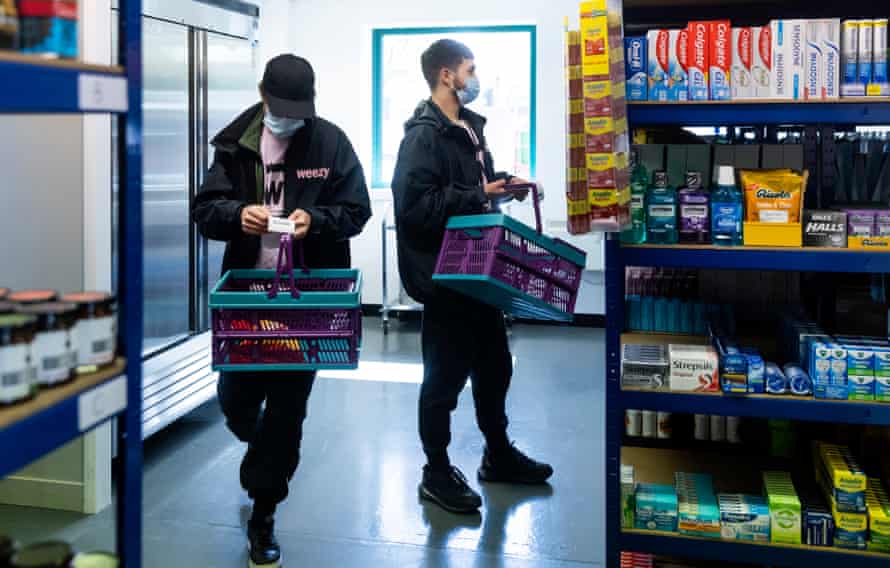
His argument is that a single dark store, paying a low rent (about £50,000 a year), can compete with at least a dozen high street convenience stores paying high rents (a typical Tesco Express on a high street costs £100,000-£200,000). Plus, it seems on-demand customers are prepared to spend much more per shop than they would in a convenience store. Kantar estimates that the average spend on a “basket shop” is £11; the Association of Convenience Stores says it’s £7.46 in a corner shop specifically. This is kept low by all the people popping in for nothing more than a newspaper and a pint of milk. Van Beveren won’t reveal the typical Weezy shopper’s exact basket size, but “it’s multiples of that”, adding that it’s closer to £30 than £20. Zapp says it is “more than double” the £11 figure. Higher turnover per customer, lower costs per square foot – bingo. Or that’s the idea.
Supermarkets are fully aware of the threat. Sainsbury’s started its own version called Chop Chop, which delivers food by bicycle within an hour for a £4.99 fee, in 2017. It has had success near student campuses. Ocado has a service called Zoom, which delivers to west London, again promising to be on the doorstep within 60 minutes, though it averages 37 minutes. A few weeks ago, Tesco announced its own trial version in Wolverhampton: Tesco Whoosh, with a pretty hefty delivery charge of £5 on orders over £15, £7 on smaller orders and a promise of delivering within the hour. Most, including Waitrose, Aldi, Co-op and Morrisons, have signed up with Deliveroo, paying an undisclosed cut of every order to the delivery company.
Dr Rachel Cohen, head of sociology at City, University of London specialises in the self-employed economy. She warns that it is the couriers who are likely to suffer as these businesses grow: “I have a scepticism about how sustainable this business model is, as they scale,” she says, pointing out many leading on-demand companies started off paying their workers well. “They can’t remain unprofitable; something will change. In the US, in the past, what has changed is the conditions of riders.”
Last month I tried out all the apps available in my neighbourhood in London and found most to be formidably slick. Both Dija and Weezy arrived within 11 minutes, using friendly riders on e-bikes, who supplied me with some essentials as well as an evening meal for my wife and me – wine, steak, frozen chips, hollandaise sauce – that was better quality and faster than if I had walked to my nearest Tesco Express and back. Weezy even gets its meat from a good local butcher.
I am impressed enough that when my teenage children complain about going to the end of the road to get ingredients for the next day’s breakfast, as well as some chocolate as a reward, I tell them we’ll get it from an app. Oddly, neither Weezy nor Dija stock a large bar of Dairy Milk, so I order on Getir. The app warns me they are busy (it is peak Friday evening) and it could take 20 minutes. It takes 52.
Waiting on my street in frustration, I meet a neighbour: Greg. By chance, he has ordered beer from Getir – we are waiting for the same rider. I ask why he hadn’t walked to our wonderful corner shop, run by Raj Patel, the closest our neighbourhood has to a community leader – a source of gossip as well as every conceivable lightbulb and dried spice; his shop a place where we all send our children to spend their first pocket money, knowing he will be keeping an eye on them.
Plus there’s a decent beer selection. “I didn’t feel like leaving the house – it’s been a long week,” Greg laughs. “Also, the prices are the same, more or less, and I got a free can of wine because it was my second order.”
We peer down the road hoping to see a glimpse of the rider’s purple jacket and motorbike. “I do worry that having this level of convenience isn’t good for us,” he says. “Is it programming our brains to become really lazy?”
Possibly. But that laziness could fuel multibillion-pound fortunes for those who end up being winners in this race. If those fortunes are funded by big supermarket shoppers switching some of their spending to on-demand, few will complain. But if it puts independent corner shops out of business, that’s a different matter. Next time the kids or I want chocolate, I think we’ll be wandering down the road for a catchup with Raj.
Source: theguardian.com

